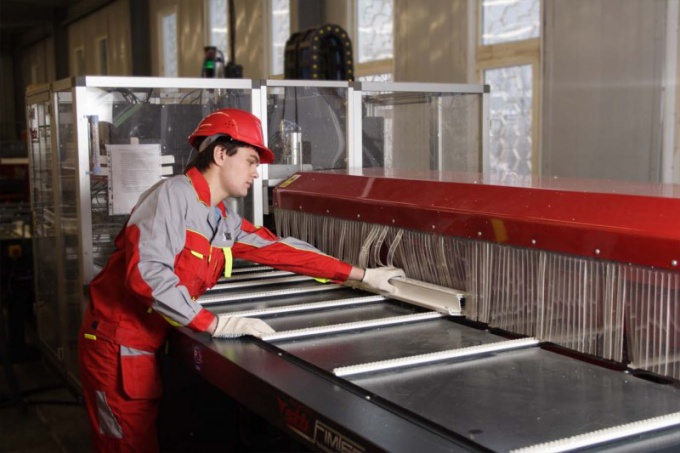In the analysis of the proportion of the cost of the used indicators as the total proportion of the production costs and share certain costs (such as material or components - raw materials, energy). The formula for calculating the specific gravity of the production costs can be summarized as follows: cost/cost * 100%.
For example, the cost of production consists of cost of raw materials (150 thousand rubles) remuneration of employees (100 thousand rubles), rent (50$) and energy costs (20 thousand rubles). Thus, the cost is 320 thousand R. it Remains to be determined what share each of the cost groups. Thus, the specific weight of costs for raw materials is 47% (150/320*100), salary - 31% (100/320*100), for rent - 16% (50/320*100), and the remaining 6% have electricity.
Typically, the analysis used not the total costs of the enterprise, and the individual cost groups. Often in economic analysis uses the following cost groups:
- material costs - the cost of outsourced materials, semi-finished and raw materials, they also include the cost of services on transportation, customs duties;
energy costs energy costs;
- costs labor - wages, compensation, benefits main production personnel ;
- deductions on social needs;
- depreciation of fixed assets is the sum of the charges for recovery of fixed assets;
- other costs (e.g., rent, mortgage payments).
Analysis of the proportion of costs required for understanding the structure of cost of production and ways of its reduction. While reducing cost is growing the revenue and profitability of the company.
In various industries the proportion of certain expenses is different. Depending on what costs are dominated, you can allocate material-intensive, time-consuming, energy-intensive industries and segments with a high weight of the cost of depreciation.
To material-intensive industries include food and light industry. In this case, the largest share of the costs necessary raw materials for production. And the reduction used in the production of raw materials (due to the rational savings) or cost leads to a reduction in cost and increase profits.
Among the time-consuming include coal, mining industry. Here the main costs fall on the wage Fund and social security contributions. Increase the profitability of production can be produced by optimizing the number of staff.
For energy-intensive industries include metal production. The most important factor of increasing returns to production is the reduction of energy consumption and reducing energy intensity.
Industries with a high share of depreciation costs is, for example, the oil and gas industry. If there is an increase in the share of depreciation in cost and in the cost of production, this indicates a decline in capital productivity.
Typically, the analysis of the proportion of the costs are measured relative to the previous period or comparing with the planned values of the accounting period.
For example, the cost of production consists of cost of raw materials (150 thousand rubles) remuneration of employees (100 thousand rubles), rent (50$) and energy costs (20 thousand rubles). Thus, the cost is 320 thousand R. it Remains to be determined what share each of the cost groups. Thus, the specific weight of costs for raw materials is 47% (150/320*100), salary - 31% (100/320*100), for rent - 16% (50/320*100), and the remaining 6% have electricity.
The types of production costs
Typically, the analysis used not the total costs of the enterprise, and the individual cost groups. Often in economic analysis uses the following cost groups:
- material costs - the cost of outsourced materials, semi-finished and raw materials, they also include the cost of services on transportation, customs duties;
energy costs energy costs;
- costs labor - wages, compensation, benefits main production personnel ;
- deductions on social needs;
- depreciation of fixed assets is the sum of the charges for recovery of fixed assets;
- other costs (e.g., rent, mortgage payments).
Analysis of the structure of production costs
Analysis of the proportion of costs required for understanding the structure of cost of production and ways of its reduction. While reducing cost is growing the revenue and profitability of the company.
In various industries the proportion of certain expenses is different. Depending on what costs are dominated, you can allocate material-intensive, time-consuming, energy-intensive industries and segments with a high weight of the cost of depreciation.
To material-intensive industries include food and light industry. In this case, the largest share of the costs necessary raw materials for production. And the reduction used in the production of raw materials (due to the rational savings) or cost leads to a reduction in cost and increase profits.
Among the time-consuming include coal, mining industry. Here the main costs fall on the wage Fund and social security contributions. Increase the profitability of production can be produced by optimizing the number of staff.
For energy-intensive industries include metal production. The most important factor of increasing returns to production is the reduction of energy consumption and reducing energy intensity.
Industries with a high share of depreciation costs is, for example, the oil and gas industry. If there is an increase in the share of depreciation in cost and in the cost of production, this indicates a decline in capital productivity.
Typically, the analysis of the proportion of the costs are measured relative to the previous period or comparing with the planned values of the accounting period.

